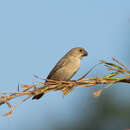Biology
(
englanti
)
tarjonnut Arkive
As its name suggests, this small bird's diet consists primarily of grass seeds. The tall grass of their habitat also provides them with cover, as they use their large feet to scratch the ground to search for food (4). Often the males can be seen perched on small trees, singing in order to defend a small area, or territory. It is thought that the black-and-tawny seedeater may be a nomadic or migratory bird, as it has been observed in certain areas only during the dry season (3).
Conservation
(
englanti
)
tarjonnut Arkive
Whilst the black-and-tawny seedeater doesn't currently receive any known conservation attention, it does occur in the Noel Kempff Mercado National Park in Bolivia, and the Pantanal Matogrossense National Park in Brazil. However, domestic animals in both these parks pose a threat, and therefore removal of them from these areas is likely to benefit the seedeater (3).
Description
(
englanti
)
tarjonnut Arkive
The name of this small bird describes the male of the species very well; it has a black back, crown and hindneck, and bright tawny, or brownish-orange, underparts. The wings and tail are blackish-brown, with a slight white edging. The cheeks are paler in colour and the bill is black. Females possess a larger bill than males, with paler plumage and less distinct patterns (2) (3). Their song is a simple series of four to six high-pitched, whistled notes (3). The scientific name, Sporophila, originates from Greek, meaning spore- or seed-loving, and refers to their preferred diet.
Habitat
(
englanti
)
tarjonnut Arkive
The black-and-tawny seedeater inhabits seasonally flooded, tall grasslands, with scattered bushes and trees (2) (3).
Range
(
englanti
)
tarjonnut Arkive
Occurs in eastern Bolivia, and south western Brazil. In Bolivia it is currently known from seven sites in eastern Santa Cruz, and in Brazil it occurs at three locations in Mato Grosso and Mato Grosso do Sul (2) (3).
Status
(
englanti
)
tarjonnut Arkive
Classified as Vulnerable (VU) on the IUCN Red List 2006 (1).
Threats
(
englanti
)
tarjonnut Arkive
The greatest threat to the black-and-tawny seedeater is habitat loss. Extensive areas of grassland have been converted for agriculture. Intensive cattle-grazing and trampling by livestock may also impact potential breeding sites (3).
Black-and-tawny seedeater
(
englanti
)
tarjonnut wikipedia EN
- lisenssi
- cc-by-sa-3.0
- tekijänoikeus
- Wikipedia authors and editors
Black-and-tawny seedeater: Brief Summary
(
englanti
)
tarjonnut wikipedia EN
The black-and-tawny seedeater (Sporophila nigrorufa) is a species of bird in the family Thraupidae.
It is found in the Pantanal of eastern Bolivia and adjacent southwestern Brazil. Its natural habitat is subtropical or tropical seasonally wet or flooded lowland grassland. It is threatened by habitat loss.

It is also sparsely found in La Pampa Province in Argentina.
- lisenssi
- cc-by-sa-3.0
- tekijänoikeus
- Wikipedia authors and editors


